Author: AnandTech
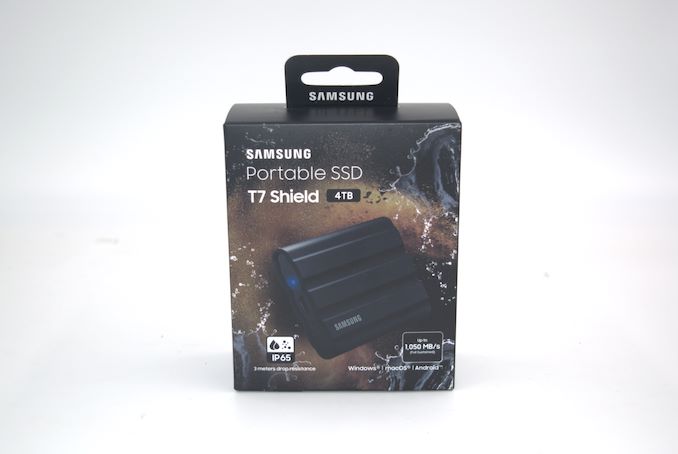
Samsung has been enjoying market success with their lineup of portable SSDs, starting with the T1 back in 2015. The company has been regularly updating their PSSD lineup with the evolution of different high-speed interfaces as well as NAND flash technology.
In early 2022, the company launched the Portable SSD T7 Shield, a follow-up to the Portable SSD T7 (Touch) introduced in early 2020. Introduced in models with capacities up to 2TB, the ruggedness / IP65 rating of the T7 Shield was advertised as a selling point over the regular Portable SSD T7 and T7 Touch. The company launched a 4TB version in this lineup in mid-January for the EU market. Samsung is officially bringing over the new capacity SKU to the North American market today. The review below provides a comprehensive look at the performance and value proposition of the Portable SSD T7 Shield 4TB.
External bus-powered storage devices capable of 1GBps+ performance have become entry-level offerings in the market today. Rapid advancements in flash technology (including the advent of 3D NAND and NVMe) as well as faster host interfaces (such as Thunderbolt 3 and USB 3.2 Gen 2+) have been key enablers. Broadly speaking, there are five distinct performance levels in this market:
- 2GBps+ drives with Thunderbolt 3 or USB4, using NVMe SSDs
- 2GBps drives with USB 3.2 Gen 2×2, using NVMe SSDs or direct USB flash drive (UFD) controllers
- 1GBps drives with USB 3.2 Gen 2, using NVMe SSDs or direct UFD controllers
- 500MBps drives with USB 3.2 Gen 1 (or, Gen 2, in some cases), using SATA SSDs
- Sub-400MBps drives with USB 3.2 Gen 1, using UFD controllers
The Samsung Portable SSD T7 Shield we are looking at today belongs to the third category in the above list, utilizing a NVMe SSD behind an ASMedia ASM2362 bridge chip. The 4TB version we are looking at today is essentially the same as the 2TB version we reviewed last year, with the only differences being in the external elastomer covering’s color and the number of flash packages on the board. As a reminder, the T7 Shield has an industrial design that can protect the drive against dust ingress and splashes of water (IP65), as well as lend it an element of ruggedness.
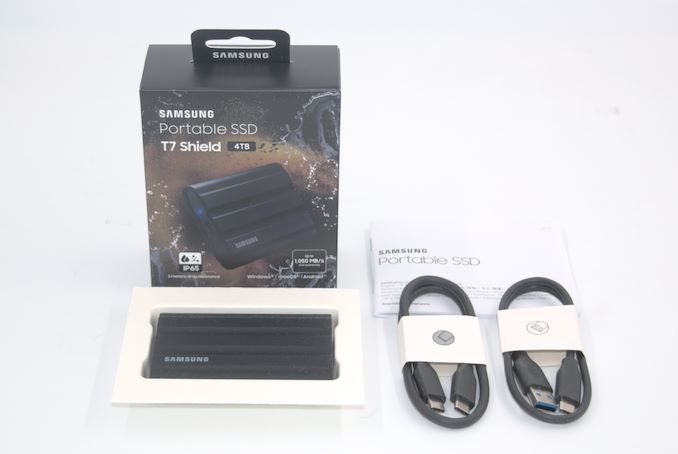
Samsung includes two separate cables – one USB Type-C to Type-A, and another Type-C to Type-C of approximately the same length. Disassembling the unit is fairly trivial after taking out the four screws hidden under the product label stickers on either side, and removing the elastomer covering. This reveals an aluminum metal enclosure. The plastic tray holding the actual PSSD board can then be slid out after the removal of the plastic piece opposite the connector end. Both plastic end pieces have grommets around their periphery to ensure a good seal and contribute to the IP65 rating. The main board is held on to the plastic tray by four smaller screws. The connector on the main board has a red-colored sealing band to ensure that it doesn’t become an ingress point for external material. The gallery below includes pictures from the teardown process.
Gallery: Samsung Portable SSD T7 Shield 4TB Teardown
Similar to the 2TB version, the 4TB version is also single-sided (but includes a thermal pad on the empty side). The SSD controller is the Pablo S4LR033 (also used in the Samsung SSD 980), and the ASMedia ASM2362 bridge chip is right next to it. The SSD subsystem in the PSSD T7 Shield is a DRAM-less one, and is pretty much the same as that of the T7 Touch – except for the flash packages. The four flash chips on board have the K9DVGB8J1B tag (against the K9DVGY8J5A in the PSSD T7 Touch). This part number decodes as: TLC, 6th gen V-NAND (128L / 136T), 512Gbit per die, 16 dies, 1TB for the whole package. This is the same NAND package used in Samsung 870 EVO SATA SSD.
Internal PSSD Board on the 2TB Version
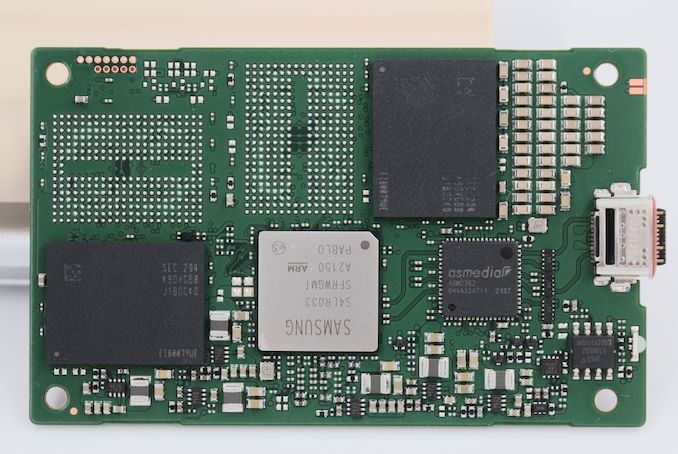
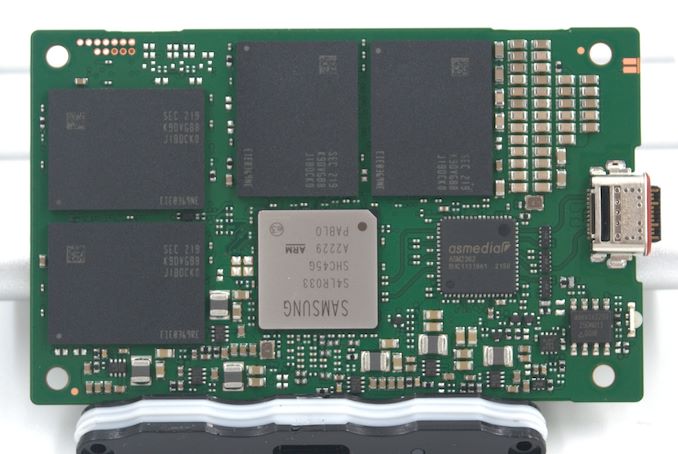
Internal PSSD Board on the 4TB Version
The review compares the Samsung Portable SSD T7 Shield 4TB against the following:
- Crucial X6 4TB
- SanDisk Extreme PRO v2 4TB
- Samsung T7 Shield 2TB
- Samsung T7 Touch 1TB
It must be noted that there are no apples-to-apples comparison in the above list. The Crucial X6 uses the Phison U17, a native flash controller. However, like the T7 Shield, it is also a USB 3.2 Gen 2 PSSD. The SanDisk Extreme PRO v2 in the list is at the same capacity point as the T7 Shield, but comes with a USB 3.2 Gen 2×2 upstream interface. The two other Samsung PSSDs are representative of the same PSSD family at different capacity points.
A quick overview of the internal capabilities of the storage devices is given by CrystalDiskInfo. The Samsung PSSD T7 Shield supports full S.M.A.R.T passthrough, along with TRIM to ensure consistent performance for the drive over its lifetime.
Comparative Direct-Attached Storage Devices Configuration Aspect Downstream Port PCIe 3.0 x2 Native Flash Upstream Port USB 3.2 Gen 2 Type-C USB 3.2 Gen 2 Type-C Bridge Chip ASMedia ASM2362 Phison U17 Power Bus Powered Bus Powered Use Case Light-weight 1GBps-class portable SSD with a durability focus (IP65 rating) Affordable 800MBps, compact, and durable portable SSD in a pocketable form-factor Physical Dimensions 88 mm x 59 mm x 13 mm 69 mm x 64 mm x 11 mm Weight 98 grams 41 grams (without cable) Cable 45 cm USB 3.2 Gen 2 Type-C to Type-C
45 cm USB 3.2 Gen 2 Type-C to Type-A 24 cm USB 3.2 Gen 2 Type-C to Type-C
Type-C to Type-A adapter sold separately S.M.A.R.T Passthrough Yes Yes UASP Support Yes Yes TRIM Passthrough Yes Yes Hardware Encryption Yes Not Available Evaluated Storage Samsung 136L V-NAND (6th Gen.) Micron 96L 3D QLC Price USD 410 USD 481 Review Link Samsung Portable SSD T7 Shield 4TB Review Crucial X6 Portable SSD 4TB Review
Prior to looking at the benchmark numbers, power consumption, and thermal solution effectiveness, a description of the testbed setup and evaluation methodology is provided.
Testbed Setup and Evaluation Methodology
Direct-attached storage devices (including portable SSDs) are evaluated using the Quartz Canyon NUC (essentially, the Xeon / ECC version of the Ghost Canyon NUC) configured with 2x 16GB DDR4-2667 ECC SODIMMs and a PCIe 3.0 x4 NVMe SSD – the IM2P33E8 1TB from ADATA.
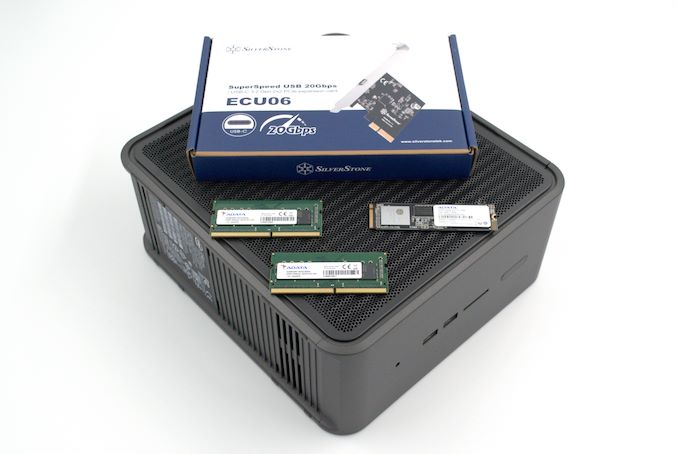
The most attractive aspect of the Quartz Canyon NUC is the presence of two PCIe slots (electrically, x16 and x4) for add-in cards. In the absence of a discrete GPU – for which there is no need in a DAS testbed – both slots are available. In fact, we also added a spare SanDisk Extreme PRO M.2 NVMe SSD to the CPU direct-attached M.2 22110 slot in the baseboard in order to avoid DMI bottlenecks when evaluating Thunderbolt 3 devices. This still allows for two add-in cards operating at x8 (x16 electrical) and x4 (x4 electrical). Since the Quartz Canyon NUC doesn’t have a native USB 3.2 Gen 2×2 port, Silverstone’s SST-ECU06 add-in card was installed in the x4 slot. All non-Thunderbolt devices are tested using the Type-C port enabled by the SST-ECU06.
The specifications of the testbed are summarized in the table below:
The 2021 AnandTech DAS Testbed Configuration System Intel Quartz Canyon NUC9vXQNX CPU Intel Xeon E-2286M Memory ADATA Industrial AD4B3200716G22
32 GB (2x 16GB)
DDR4-3200 ECC @ 22-22-22-52 OS Drive ADATA Industrial IM2P33E8 NVMe 1TB Secondary Drive SanDisk Extreme PRO M.2 NVMe 3D SSD 1TB Add-on Card SilverStone Tek SST-ECU06 USB 3.2 Gen 2×2 Type-C Host OS Windows 10 Enterprise x64 (21H1) Thanks to ADATA, Intel, and SilverStone Tek for the build components
The testbed hardware is only one segment of the evaluation. Over the last few years, the typical direct-attached storage workloads for memory cards have also evolved. High bit-rate 4K videos at 60fps have become quite common, and 8K videos are starting to make an appearance. Game install sizes have also grown steadily even in portable game consoles, thanks to high resolution textures and artwork. Keeping these in mind, our evaluation scheme for direct-attached storage devices involves multiple workloads which are described in detail in the corresponding sections.
- Synthetic workloads using CrystalDiskMark and ATTO
- Real-world access traces using PCMark 10’s storage benchmark
- Custom robocopy workloads reflective of typical DAS usage
- Sequential write stress test
In the next section, we have an overview of the performance of the Samsung Portable SSD T7 Shield in these benchmarks. Prior to providing concluding remarks, we have some observations on the PSSD’s power consumption numbers and thermal solution also.
Benchmarks such as ATTO and CrystalDiskMark help provide a quick look at the performance of the direct-attached storage device. The results translate to the instantaneous performance numbers that consumers can expect for specific workloads, but do not account for changes in behavior when the unit is subject to long-term conditioning and/or thermal throttling. Yet another use of these synthetic benchmarks is the ability to gather information regarding support for specific storage device features that affect performance.
Samsung claims speeds of up to 1050 MBps for the T7 Shield 4TB version. Our ATTO testing configuration manages to reach numbers quite close to the advertised one. However, we only use a single queue depth of 4 – so, it is only representative of a small subset of real-world workloads. It does allow the visualization of change in transfer rates as the I/O size changes, with optimal performance being reached around 512 KB for a queue depth of 4. The most interesting comparison in the set below is actually against the 2TB version of the T7 Shield. We find that for the same access trace, there is a slight drop in performance.
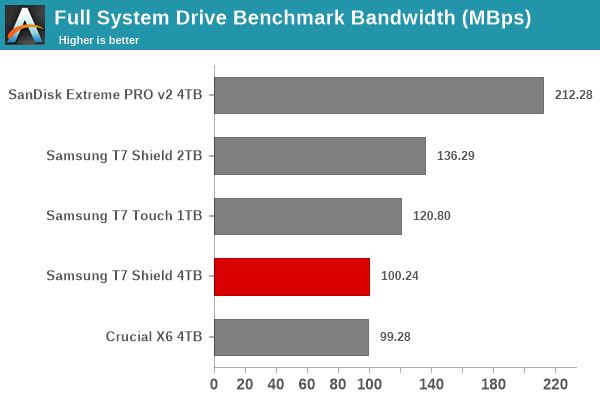
Overall, the 4TB T7 Shield surprisingly slots in closer to the Crucial X6 rather than the other PSSDs – a result of the drive’s abysmal random access numbers.
The performance of the storage bridges / drives in various real-world access traces as well as synthetic workloads was brought out in the preceding sections. We also looked at the performance consistency for these cases. Power users may also be interested in performance consistency under worst-case conditions, as well as drive power consumption. The latter is also important when used with battery powered devices such as notebooks and smartphones. Pricing is also an important aspect. We analyze each of these in detail below.
Worst-Case Performance Consistency
Flash-based storage devices tend to slow down in unpredictable ways when subject to a large number of small-sized random writes. Many benchmarks use that scheme to pre-condition devices prior to the actual testing in order to get a worst-case representative number. Fortunately, such workloads are uncommon for direct-attached storage devices, where workloads are largely sequential in nature. Use of SLC caching as well as firmware caps to prevent overheating may cause drop in write speeds when a flash-based DAS device is subject to sustained sequential writes.
Our Sequential Writes Performance Consistency Test configures the device as a raw physical disk (after deleting configured volumes). A fio workload is set up to write sequential data to the raw drive with a block size of 128K and iodepth of 32 to cover 90% of the drive capacity. The internal temperature is recorded at either end of the workload, while the instantaneous write data rate and cumulative total write data amount are recorded at 1-second intervals.
CrystalDiskMark Workloads – Power Consumption TOP: BOTTOM: 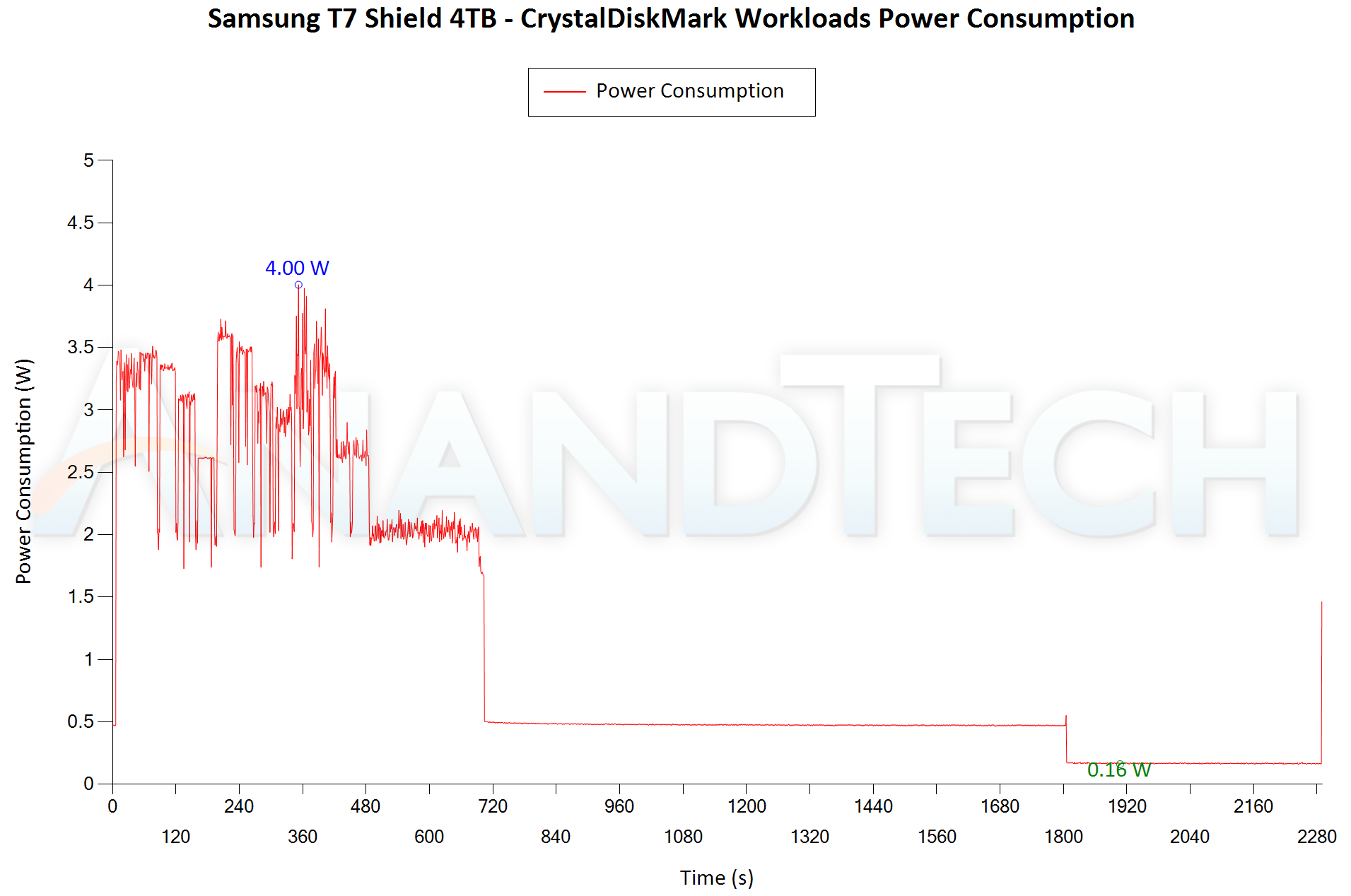
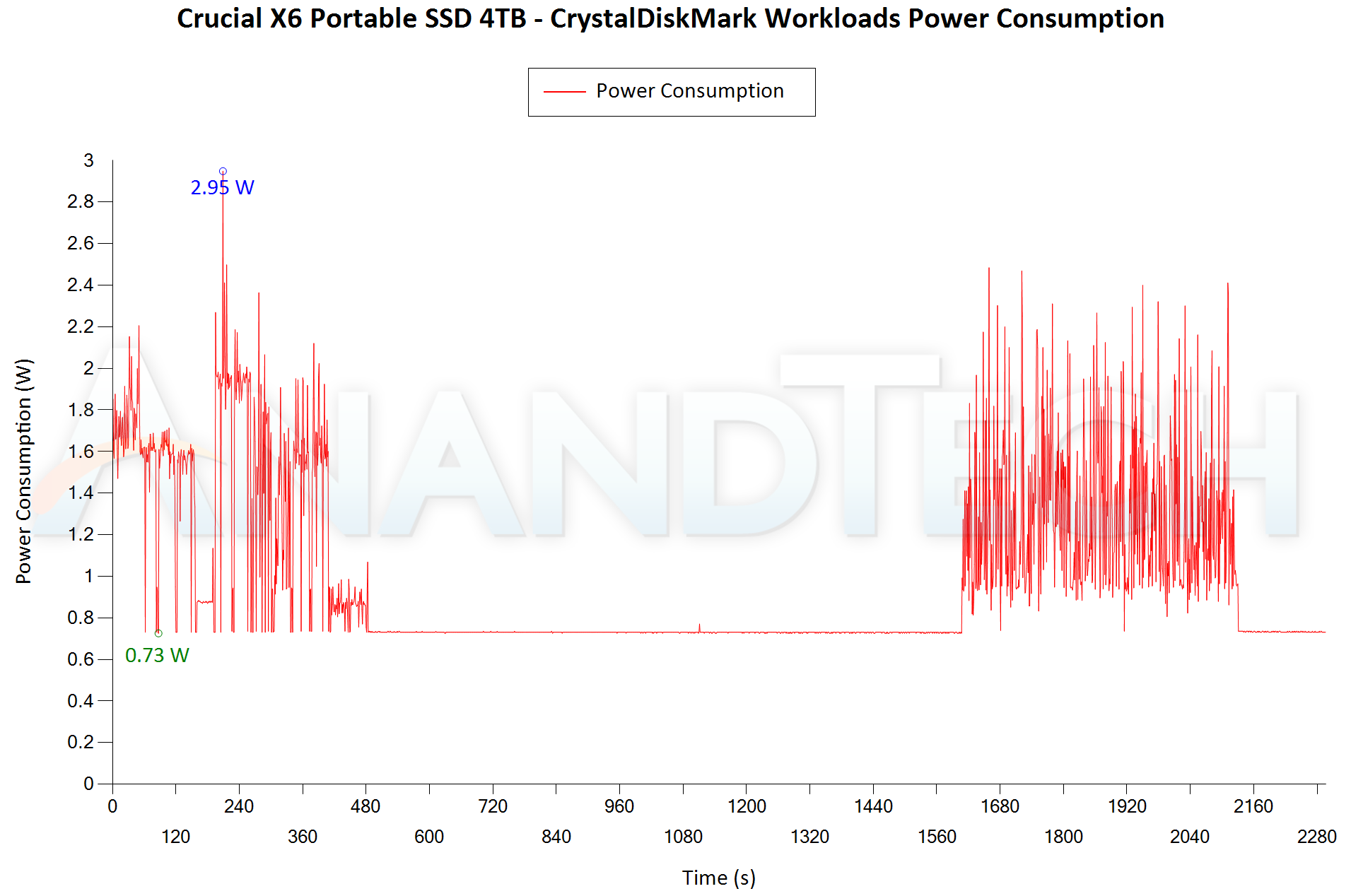
Despite the additional flash packages, the power consumption profile of the 4TB version is very similar to that of the 2TB version. Peak power consumption is around 4W, and there is a deep-sleep mode after 15 or so minutes of inactivity where the PSSD draws just 160 mW from the host.
Concluding Remarks
The Samsung Portable SSD T7 Shield 4TB version is available for purchase today. The official launch MSRP is $430, but we already saw the PSSD for sale at $410. This pricing is completely untenable, given the price of competing PSSDs. The SanDisk Extreme PRO v2 comes with a USB 3.2 Gen 2×2 20 Gbps interface, has a much better performance profile across all considered workloads, and the 4TB version is currently available for $360. On the flip side, it is only IP55-rated, and the power consumption numbers are a bit on the higher side.
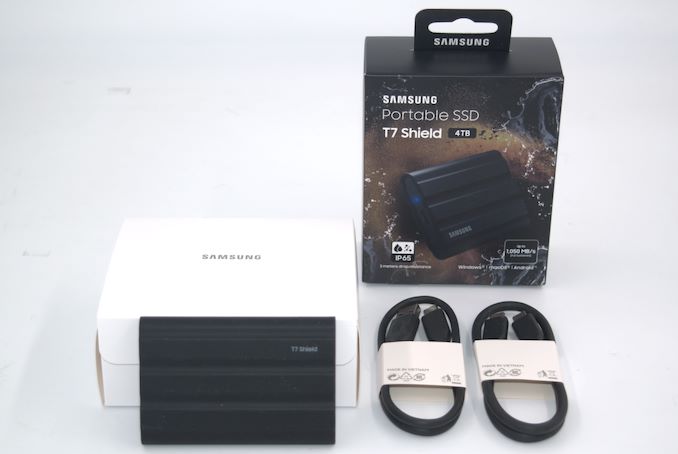
If the PSSD is priced between $250 and $300 (closer to the Crucial X6), one can look past the disappointing random access performance and the DRAM-less nature that affects performance for workloads of power users (including application launches and read/write of small files). Even at the higher end of that pricing spectrum, one can say that the PSSD would deliver excellent value for typical direct-attached storage workloads. The IP65 rating and low power consumption, coupled with the hardware encryption capabilities (controllable via the Samsung Portable SSD Software) are important value additions. Samsung’s upcoming release of their Magician software is also expected to introduce cloning of internal SSDs to PSSDs such as the T7 Shield.
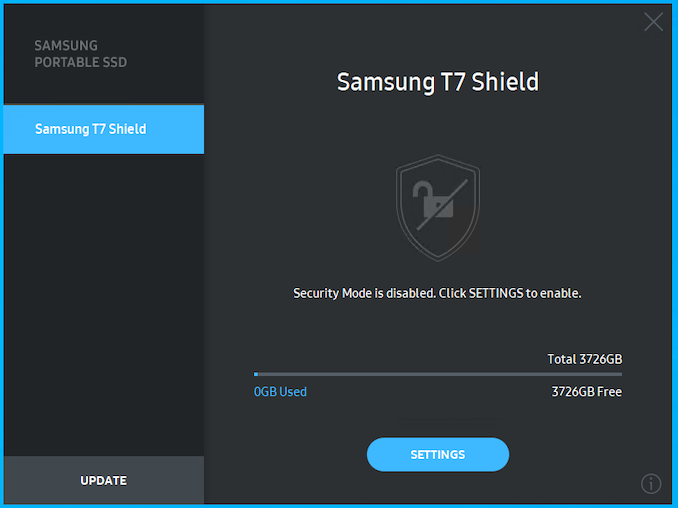
In terms of scope for improvement, we believe Samsung should offer DRAM-equipped PSSDs in a slightly premium line – those could deliver better performance for non-DAS workloads (and PSSDs are starting to get treated on par with internal SSDs by power users already). They could also explore supplying a single Type-C to Type-C cable along with an attached Type-C to Type-A adapter.
In conclusion, while the performance and feature set of the Portable SSD T7 Shield are acceptable for an entry-level PSSD, the pricing appears to be one meant for a high-end one. The market deserves a wider range of PSSD offerings from Samsung with varied performance levels and commensurate pricing.






